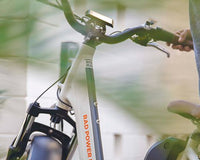Outside belongs to everyone, and when it comes to exploring it, an ebike is the most accessible option. In fact, accessibility is built right into Rad Power Bikes' mission statement!
Throughout the month of March, we’re highlighting the ways in which nature and ebikes go hand-in-hand -- from the health benefits of using your ebike for exercise to the products that can keep you on the road longer. It's also Women's History Month, and we're showcasing the women riders who are using our ebikes to get outside like never before.
Have you ever wondered what kind of a workout you’re getting when you take your electric bike out for a spin?
You're not the only one -- it's a question we get regularly. And while we’ve previously written blog posts that debunk the idea that ebikes are cheating and highlight the health benefits they’ve brought to our riders' lives, we wanted to dive a little bit deeper.
So for this edition of Test Ride Tuesday, we ran an experiment.
Now, bear in mind, we're not even close to being doctors. We used run-of-the-mill activity trackers, rode at different speeds and cadences and on different terrain surfaces depending on our comfort levels on a bike. We were on different Rad bikes, and we were wildly different shapes and sizes of humans. Needless to say, this was not a controlled experiment, and your results will most definitely vary from ours.
We took five riders and sent them on a 5-mile loop around our Seattle headquarters, one that included a mix of flats and hills. We assigned each of them a different level of pedal assist, which determines how much power the motor supplies. The higher the level of PAS, the more power that comes through when pedaling (think of level 1 as a cup of tea to get your morning started and level 5 as a third pot of coffee that helps you hit a midnight deadline.)

To track how many calories each rider burned, we equipped them with heart rate monitors. Here’s what the results looked like:
Results from a 5 mile, mixed-terrain loop over ~ 30-40 minutes.
| Pedal Assist Level | Rider Height and Weight | Calories Burnt |
| Level 1 | 6'3", 250 Lbs | 325 |
| Level 2 | 5'3", 94 Lbs | 121 |
| Level 3 | 6'4", 205 Lbs | 183 |
| Level 4 | 5'1", 108 Lbs | 98 |
| Level 5 | 5'9", 185 Lbs | 179 |
We were a little surprised. We naturally expected that a lower level of pedal assist would automatically equal more calories burned.
To help us interpret these results, we turned to our friend Randy, a Rad Power Bikes Customer Experience whiz who’s also a certified personal trainer.
“A lot of this comes down to body size, body mass index, and an individual’s cardiovascular health. If you have a greater BMI and are new to getting in shape, you’re going to burn more calories when you ride.”
Regardless, Randy noted, an ebike can help you work out. The results come down to the amount of energy exerted by each rider -- no matter what the level of pedal assist is that they’re using.
This is determined by intensity, which can be actually measured via something called the Metabolic Equivalent of Task, or MET for short. In a nutshell, this determines the amount of energy a person expends relative to their overall size.
Scientists use METs to measure all sorts of tasks. When you’re walking around your office, for example, that has an MET value of about 3.5. When you ride a traditional bicycle for fun, that has an MET value of 6.
When you pedal hard on an electric bike, you can control its MET value. One study said riding an ebike at a comfortable speed has an average MET value of 5.2 -- a little higher than riding a stationary cycle.
“You’re still getting a workout, and the great thing about electric bikes is that they’re fun. If you find an activity that’s fun and healthy, you’re going to be more likely to stick with it, which is good news for your long-term fitness goals.”

This is not a controlled science experiment and is not intended to make any kind of health or medical claim. Don't ride in conditions that exceed your or your bike’s ability.








